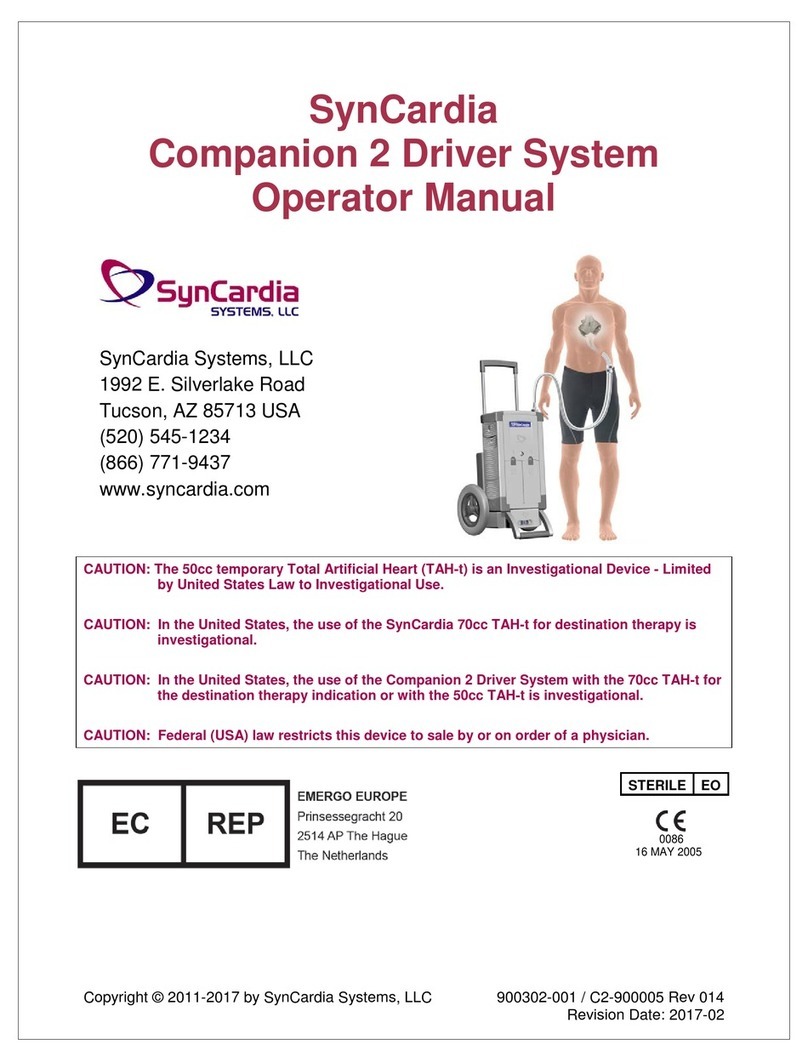
SynCardia Systems, LLC
Freedom®Driver System Operator Manual Page 5 of 170
TABLE OF FIGURES
Figure 1-1 – 50cc or 70cc TAH-t with the Freedom Driver System ...........................9
Figure 1-2 – The SynCardia 70cc TAH-t and 50cc TAH-t .........................................10
Figure 1-3 – Freedom Driver with Attached Power Adaptor and Drivelines
Connected to the Cannulae of a TAH-t......................................................................11
Figure 1-4 Exploded View of the Freedom Driver System.......................................16
Figure 1-5 – Primary Freedom Driver with attached Power Adaptor and Two
Inserted Onboard Batteries........................................................................................17
Figure 1-6 – Backup Freedom Driver with attached Power Adaptor and Inserted
Dummy Battery............................................................................................................20
Figure 1-7 – Power Adaptor........................................................................................21
Figure 1-8 – Onboard Battery.....................................................................................22
Figure 1-9 – Hospital AC Power Supply....................................................................23
Figure 1-10 – Home AC Power Supply ......................................................................24
Figure 1-11 – AC Power Supply and Cord.................................................................25
Figure 1-12 – Car Charger ..........................................................................................26
Figure 1-13 – Battery Charger....................................................................................26
Figure 1-14 – Dummy Battery.....................................................................................28
Figure 1-15 – Filter Pack, Screwdriver and Screws..................................................29
Figure 1-16 – Patient Tool Kit.....................................................................................30
Figure 1-17 – Shoulder Bag........................................................................................31
Figure 1-18 – Backpack ..............................................................................................31
Figure 1-19 – Shoulder Bag with Rain Cover............................................................33
Figure 1-20 – Backpack with Rain Cover ..................................................................33
Figure 1-21 – Accessory Bag .....................................................................................34
Figure 1-22 – Pelican Case.........................................................................................34
Figure 1-23 – Clinician Tool Kit..................................................................................35
Figure 1-24 – Connector Kit .......................................................................................36
Figure 6-1 – Unplugging the Power Adaptor from the Freedom Driver..................69
Figure 6-2 – Removing the Power Adaptor from the Freedom Driver ....................70
Figure 6-3 – Plugging the Green Connector into the Green Power Adaptor
Receptacle...................................................................................................................71
Figure 6-4 – Connection to External Power via the AC Power Supply...................71
Figure 6-5 – Removing the Green Connector from the Green Power Adaptor
Receptacle...................................................................................................................76
Figure 6-6 – Battery Fuel Gauge ................................................................................78
Figure 6-7 – Correct Onboard Battery Insertion into Battery Well..........................79
Figure 6-8 – Battery Charger and Bays.....................................................................80
Figure 6-9 – Connect AC Power Supply and Battery Charger.................................80
Figure 6-10 – Driver LCD Screen ...............................................................................82
Figure 7-1 – Driveline Caps........................................................................................88
Figure 7-2 – Beat Rate Setting Dial on the Back of the Freedom Driver.................89
Figure 10-1 – Illuminated Flashing Yellow Battery Alarm Light..............................99
Figure 10-2 – Illuminated Flashing Red Temperature Alarm Light .......................102
Figure 10-3 – Illuminated Solid Red Fault Alarm Light ..........................................103





























